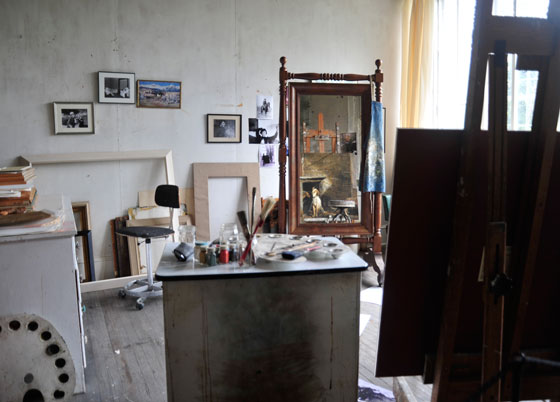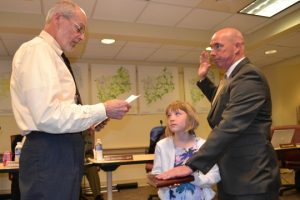A part of Andrew Wyeth’s
private life will become public this summer when the Brandywine River Museum
opens his former home and studio to public tours.
“Andrew Wyeth is one of the
most beloved artists in American History and he was actually a very private
person. It’s really wonderful to see the private studio where he painted some
of his most famous works and enter his private world. It’s a really unique
opportunity,” said Hillary Holland, director of public relations for the
Brandywine Conservancy.
There are photos, sketches and
reproduced paintings throughout the old house and studio that Andrew and Betsy
Wyeth called home from 1940 to 1961. The artist continued to use the studio
there until 2008.
In the entranceway is a poster
of the late U.S. Sen. Edward Kennedy done by Jamie Wyeth and signed by Kennedy.
Jamie then gave it to his father. There are numerous other photos of family,
friends, actors and models in the front room.
The entranceway, kitchen,
library, living room and studio itself will be part of the tour. All have been
restored to how they were when the artist was living and working there. Some of
the restorations were recreated from the memories of sons Jamie and Nicholas
Wyeth, as well as friend George A. “Frolic” Weymouth.
“The studio became Andy’s
world,” said guide and interpreter Mary Nell Ferry.
Yet, she added that the library
“shows Andrew the man,” and his wide range of interests. There are hundreds of
books on everything from art to history and a skeleton in the corner that he
gave to Jamie for Halloween.
However, the man is revealed in
other rooms as well. In the old living room, there are Wyeth’s 1,250 toy
soldiers that he collected all his life and a window sill with fencing swords
and a mask. The artist was sickly as a child and fencing helped him restore his
strength.
The living room has a copy of
N.C. Wyeth’s “Old Pew.” Ferry said N.C.’s imagination helped fuel Andrew’s.
Jamie Wyeth also used the
living room as a studio for a few years — from 1961-1968. Included on display
are copies of his John F. Kennedy portrait and other sketches. It was in that
space where he painted “Draft Age.”
Part of the tour includes a
four-minute video of Jamie talking about the importance of showing his
father’s studio.
“To see the space where Andy
worked opens a new world to the audience,” he says in the video. “It gives a
new dimension to his work.”
The kitchen area, added in the
1950s, will show different paintings over the fireplace because Andy always
changed what was hanging there, Ferry said. He would hang a recently finished
painting there, then get reaction from family and friends.
“It was a changing showplace,”
she said.
Other objects in the kitchen,
including a day bed, long table and refrigerator, are part of the re-creation.
The studio is the heart of the
tour. It was there where he created thousands of paintings — including
“Pennsylvania Landscape” — that helped make him famous.
There, too, are studies and
photographs along with the reproduction of “Racoon,” showing chained dogs by a
table. Visitors to the studio view the image through the reflection of a
mirror.
Ferry said Wyeth would check
his paintings in the mirror and upside down for composition.
“He considered himself an
abstract painter,” Ferry said. “You check your work and it should be just as
pleasing in that position as it was in the upright position.”
Sketches, studies and quick
watercolors are all around the studio, on the walls and on the floor. Ferry
said the watercolors allowed Wyeth to catch his moments, his quick thoughts.
Public tours are scheduled to
start July 3, but members of the Brandywine Conservancy may begin touring the
house in June. Tours will be limited to 14 people. The cost will be $8 plus the
price of admission to the museum.
Curator Christine Podmaninczky
said it took the museum more than a year to get the studio ready. All the original
items — including the library books and 1,250 toy soldiers — had to be
catalogued, removed and then returned to their original positions.
The building had to be
improved. A new roof was put on and the ceiling was reinforced.
The Wyeths moved into the house
after Peter Hurd and his wife Henriette moved out of the small structure that
was once a schoolhouse. Hurd was Andrew Wyeth’s brother-in-law and Henriette
his sister.
It was originally built as a
schoolhouse in 1875. N.C. Wyeth bought the property in 1925. It’s within
walking distance of the N.C. Wyeth house and studio.
The museum also runs tours of
the N.C. Wyeth Studio and the Kuerner Farm.
About Rich Schwartzman
Rich Schwartzman has been reporting on events in the greater Chadds Ford area since September 2001 when he became the founding editor of The Chadds Ford Post. In April 2009 he became managing editor of ChaddsFordLive. He is also an award-winning photographer.



Comments